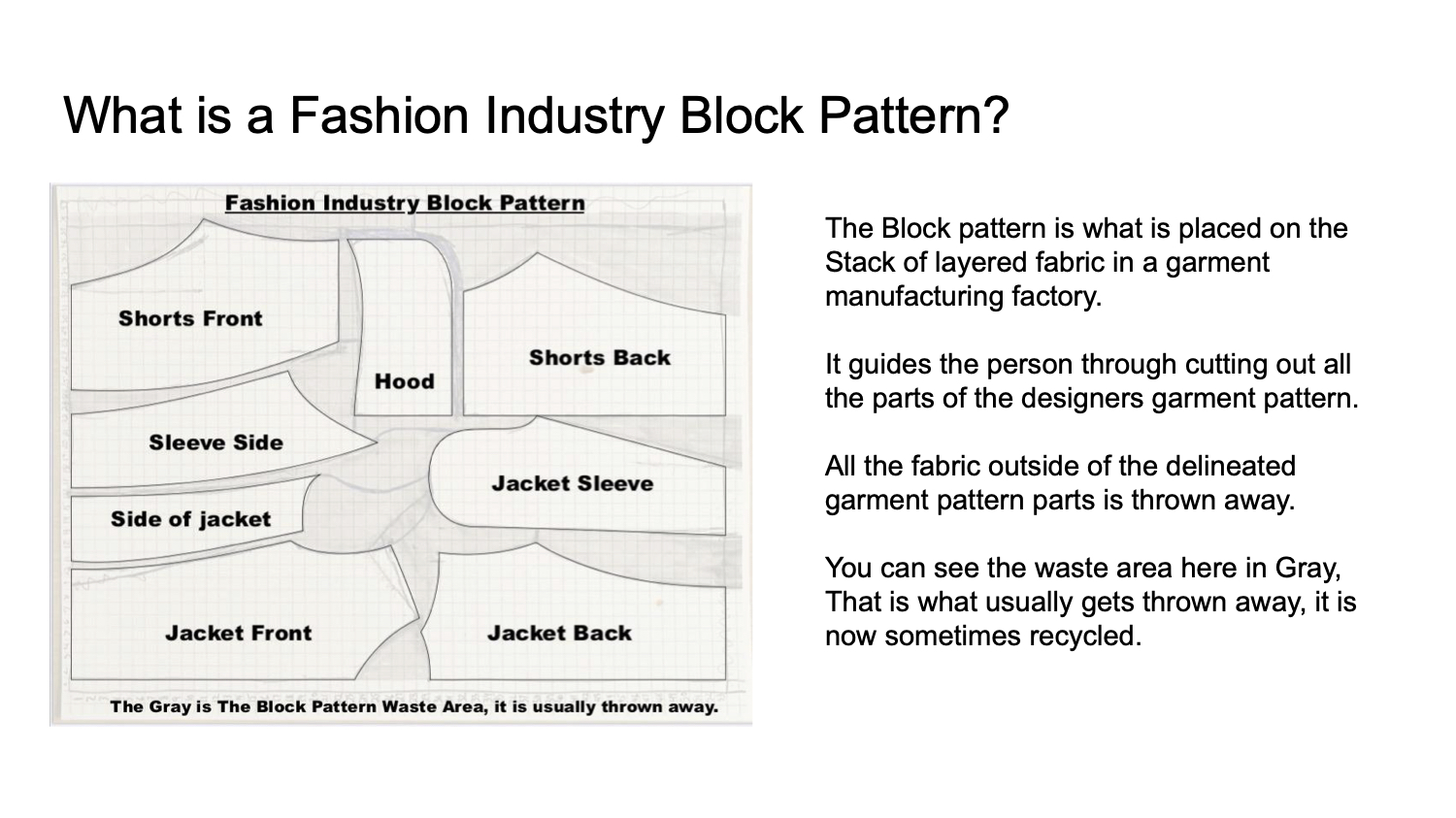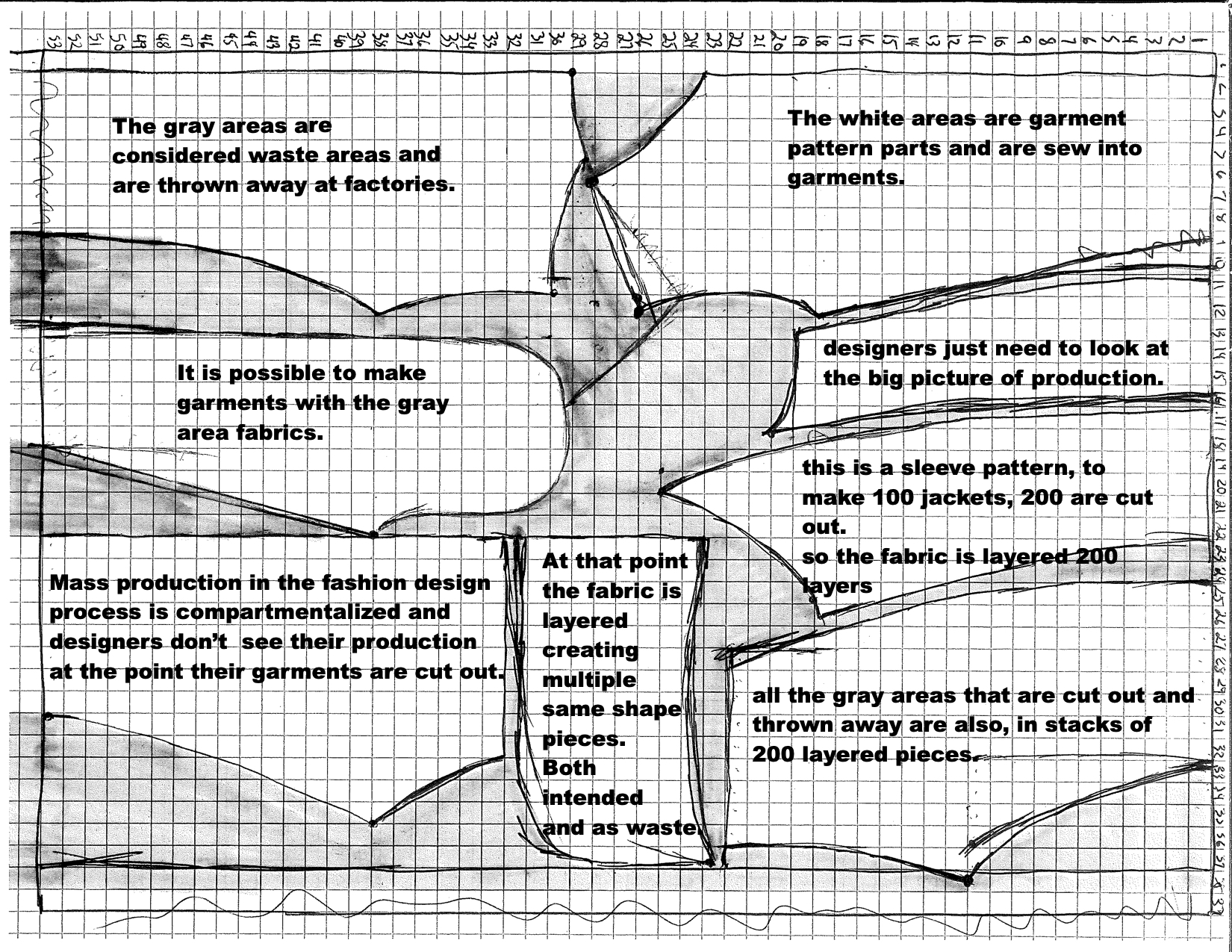Melissa Lockwood
Melissa Joyce Lockwood
(
Private sector
)
#SDGAction46558
Description
Melissa Lockwood is an interdisciplinary artist who has been creating garments with fashion industry waste fabrics in NYC for 10+ years.
With so much fabric going into the landfills it is important for designers to learn to keep fabrics in use. The fashion industry is the number three industry causing global impacting pollution.
The fashion industry's current wasteful, polluting production methods need to collapse and be replaced by a new zero waste system.
Melissa has developed a method that utilizes the waste fabric areas in fashion pattern layout. The method she developed creates additional garments from the pattern layout waste areas that are usually sent to the landfill.
Her project explains how designers can make more garments and less landfill waste by learning to design into their waste fabric areas, specifically the pattern layout waste areas.
Melissa’s research has been focused on analyzing fashion pattern layout waste fabrics, this is the area outside of and surrounding the intended garment pattern pieces. This fabric is thrown away in massive quantities at the factories.
During her research of fashion industry waste fabrics she discovered a technique that can lower fashion industry waste fabrics globally. Melissa noticed a glitch in the production system, massive quantities of fabric is being deposited into the landfills. It happened that the fabrics in the dumpsters had something in common. The fabric was in stacks of same shape pieces. The stacks had many pieces all the same shape.
As Melissa watched fabric being cut out in a factory she noticed that all the intended garment pieces were cut out in stacks of multiple same shape pieces. Simultaneously the waste pieces were cut out in the same number of pieces, these were thrown away.
When Melissa collected samples of the discarded stacks of fabric, she noticed that many of the pieces were long and narrow widening at one end. Melissa intuitively decided to create a cylinder with the pieces, she didn’t alter the shapes of the pieces and cylinders were easily formed Melissa adjusted these into dresses, skirts and capes. This concept and process can be applied to any mass production block pattern.
The premise of Melissa’s project is to identify and utilize the long narrow widening at one end pieces of fabric found in the pattern layout waste areas. Melissa has found that the stacks of same shape pieces are usable, through application of radial projection. By applying radial projection to these same shape pieces the creation of cylindrical structures is easily accomplished and thus wearable garments are easily made.
The Impact of this project depends on the number of fashion designers to adopt this practice. This project can make a significant impact when mass producing global designers incorporate this idea into their practices. Finding any usable stacks of same shape pieces in the pattern layout waste areas will create more garments and less landfill waste.
The design and production of clothing made from the pattern layout waste area will be an improvement over depositing these fabrics in the landfills. What is unique about this project is that it looks and the mass production pattern layout layers as a design area. Utilizing the multiple same shape pieces as a design concept.
Melissa expects that this concept will be employed and major improvements will be made. It is a simple procedure. She can easily teach designers to utilize this process.
To understand and utilize this concept, designers will need to let form follow function. In this instance, Melissa means in order to lower fashion industry waste flexibility in design control will need to happen. Since the shapes are determined by the unique original pattern parts. The designer will need to allow the predetermined shapes that are a byproduct of the pattern layout. To adjust the pattern layout to maximize the usage of the pattern layout waste fabrics.
The shapes created by traditional garments pattern layout create repeatedly usable shapes for garment creation with the waste fabrics.
Melissa’s experiments are wearable and easy to make, considered fashion forward, stylish and collections are featured in Vogue and other publications.
The need has arrived to reduce the waste stream of fabric into landfills. Fabric waste is hurting our planet through its excess production and discard as pre-consumer and post consumer waste. It is estimated that 92 million tons of textile waste is created annually by the fashion industry. The production and waste are causing pollution both on land, in the atmosphere and our oceans.
Melissa’s project focuses of pre-consumer waste fabrics produced during the cut out of garments at mass producing factories. She pinpoints mass production pattern layout fabrics.
During her research of fashion industry waste fabrics, she discovered a technique that can lower fashion industry waste fabrics globally. Melissa noticed a glitch in the production system, massive quantities of pre consumer fabrics are being deposited into the landfills.
While observing garments being cut out in a factory Melissa noticed that all the intended garment pieces were cut out in stacks of multiple same shape pieces and the waste pieces were cut out in the same number of pieces and were thrown away.
Additionally, Melissa noticed that many of the pieces were long and narrow, widening at one end, she intuitively without altering of the shapes of the pieces created cylinders and garments wereeasily formed.
Melissa has created a method that uses radial project in garment conceptualization based on pattern layout of discard fabric shapes found in fashion pattern layout waste.
Radial projection is applied to the stacks of same shape pieces produced in mass production pattern layout waste areas. As a production pattern layout is created with the original garment pieces and the knowledge of the quantity to be manufacture one can design with the multiple same shape pieces found in the pattern layout waste areas. This can be done in the pre-production process. Designers can design into the areas because they can quantify the number of same shape pieces and they’re sizes.
Through the use of the same shape pieces and the application of radial projection on the structure of the form makes it possible to pre determine the outcome of a 3D object from the waste fabric areas. It is possible for fashion designers to mine the layout patterns waste area for additional garments.
Patterns can be made in the “waste fabric” areas along side the original garments patterns once the layout of originating garments in formed. Patterns can be made with the “waste fabric” areas alongside the original garments patterns.
Melissa is looking for consultations with fashion designers to share this concept in detail to realize its potential.
Melissa directly workshops/teaches methods to lower fashion industry waste online and in person.
Melissa has taught at, The Putney Schools Summer Arts Program, teaching fashion design: zero waste pattern making and up-cycling. Additionally she has taught in person workshops in NYC and online live and through video.
Melissa is transferring technology and ideas as freely as possible through, fashion shows, exhibits, showrooms, pop ups, workshops, artists residencies and consultations.
Melissa is looking for designers and factories to share her research with so it will spread as a global practice.
Melissa is part of the Design Science Studio and member of the Buckminster Fuller Institute. She has had direct participation online and in person the last two years. Melissa has been researching fashion industry pattern layout waste for 12 plus years.
The goal of this project is to teach fashion designers a method that allows them to design with the fabric the usually throw away as a byproduct of their production process.
This technique transforms the waste area into a use area during the design and layout for production process.
This project when utilized will lower fashion industry greenhouse omissions. it will create positive change in the fashion industry world wide.
This is a major discovery!
http://www.arcosanti.org
Melissa's method has been tested and has achieved zero waste block patterns with traditional garment pattern layout.
This technique can transform traditional garment patterns layout to zero waste, it has been tested on pattern blocks containing: hooded jackets, pants, tops, capes and skirts.
This project creates a new vernacular in fashion design through its use of the multiple same shape pattern layout waste area pieces that are a bi-product of the design process. The acceptance of these predetermined shapes as usable is a new concept in fashion design. With 12 plus years of designing with these unique shapes Melissa has nearly show that they are usable pieces.
Design Science Studio
https://www.designscience.studio
Buckminster Fuller Institute
https://www.bfi.org
habRitual
https://www.habritual.studio
It is estimated that 92 million tons of textile waste is created annually by the fashion industry. To reduce the pre-consumer waste made during pattern layout will reduce this number significantly.
The use of the pattern area waste fabrics as a design vernacular can raise awareness about the necessity of reducing fabrics of all kinds becoming landfill waste. To show the value of the once thought of waste fabrics can emphasize the need to retain and conserve existing garments. This can help change the fashion consumer and industry away from the the trend fast fashions has created. The trend of garment discard and fabric waste needs to end. The fast fashion model has proven unsustainable and a new model needs to be implemented.
To learn to design into the once ignored pattern layout waste areas is a step in the right direction. The use of radial projection with these unique shapes creates wearable and fashionable garments adding to the fashion industries positive changes that need to happen.
SDGS & Targets
Goal 3
Ensure healthy lives and promote well-being for all at all ages
3.1
3.1.1
Maternal mortality ratio
3.1.2
Proportion of births attended by skilled health personnel
3.2
3.2.1
Under-five mortality rate
3.2.2
Neonatal mortality rate
3.3
By 2030, end the epidemics of AIDS, tuberculosis, malaria and neglected tropical diseases and combat hepatitis, water-borne diseases and other communicable diseases
3.3.1
Number of new HIV infections per 1,000 uninfected population, by sex, age and key populations
3.3.2
Tuberculosis incidence per 100,000 population
3.3.3
Malaria incidence per 1,000 population
3.3.4
Hepatitis B incidence per 100,000 population
3.3.5
Number of people requiring interventions against neglected tropical diseases
3.4
3.4.1
Mortality rate attributed to cardiovascular disease, cancer, diabetes or chronic respiratory disease
3.4.2
Suicide mortality rate
3.5
Strengthen the prevention and treatment of substance abuse, including narcotic drug abuse and harmful use of alcohol
3.5.1
Coverage of treatment interventions (pharmacological, psychosocial and rehabilitation and aftercare services) for substance use disorders
3.5.2
Alcohol per capita consumption (aged 15 years and older) within a calendar year in litres of pure alcohol
3.6
3.6.1
Death rate due to road traffic injuries
3.7
By 2030, ensure universal access to sexual and reproductive health-care services, including for family planning, information and education, and the integration of reproductive health into national strategies and programmes
3.7.1
Proportion of women of reproductive age (aged 15-49 years) who have their need for family planning satisfied with modern methods
3.7.2
Adolescent birth rate (aged 10-14 years; aged 15-19 years) per 1,000 women in that age group
3.8
Achieve universal health coverage, including financial risk protection, access to quality essential health-care services and access to safe, effective, quality and affordable essential medicines and vaccines for all
3.8.1
Coverage of essential health services
3.8.2
Proportion of population with large household expenditures on health as a share of total household expenditure or income
3.9
3.9.1
Mortality rate attributed to household and ambient air pollution
3.9.2
Mortality rate attributed to unsafe water, unsafe sanitation and lack of hygiene (exposure to unsafe Water, Sanitation and Hygiene for All (WASH) services)
3.9.3
Mortality rate attributed to unintentional poisoning
3.a
3.a.1
Age-standardized prevalence of current tobacco use among persons aged 15 years and older
3.b
Support the research and development of vaccines and medicines for the communicable and non-communicable diseases that primarily affect developing countries, provide access to affordable essential medicines and vaccines, in accordance with the Doha Declaration on the TRIPS Agreement and Public Health, which affirms the right of developing countries to use to the full the provisions in the Agreement on Trade-Related Aspects of Intellectual Property Rights regarding flexibilities to protect public health, and, in particular, provide access to medicines for all
3.b.1
Proportion of the target population covered by all vaccines included in their national programme
3.b.2
3.b.3
Proportion of health facilities that have a core set of relevant essential medicines available and affordable on a sustainable basis
3.c
3.c.1
Health worker density and distribution
3.d
Strengthen the capacity of all countries, in particular developing countries, for early warning, risk reduction and management of national and global health risks
3.d.1
International Health Regulations (IHR) capacity and health emergency preparedness
3.d.2
Percentage of bloodstream infections due to selected antimicrobial-resistant organisms
Goal 9
Build resilient infrastructure, promote inclusive and sustainable industrialization and foster innovation
9.1
9.1.1
Proportion of the rural population who live within 2 km of an all-season road
9.1.2
Passenger and freight volumes, by mode of transport
9.2
Promote inclusive and sustainable industrialization and, by 2030, significantly raise industry’s share of employment and gross domestic product, in line with national circumstances, and double its share in least developed countries
9.2.1
Manufacturing value added as a proportion of GDP and per capita
9.2.2
Manufacturing employment as a proportion of total employment
9.3
9.3.1
Proportion of small-scale industries in total industry value added
9.3.2
Proportion of small-scale industries with a loan or line of credit
9.4
By 2030, upgrade infrastructure and retrofit industries to make them sustainable, with increased resource-use efficiency and greater adoption of clean and environmentally sound technologies and industrial processes, with all countries taking action in accordance with their respective capabilities
9.4.1
CO2 emission per unit of value added
9.5
9.5.1
Research and development expenditure as a proportion of GDP
9.5.2
Researchers (in full-time equivalent) per million inhabitants
9.a
9.a.1
Total official international support (official development assistance plus other official flows) to infrastructure
9.b
9.b.1
Proportion of medium and high-tech industry value added in total value added
9.c
Significantly increase access to information and communications technology and strive to provide universal and affordable access to the Internet in least developed countries by 2020
9.c.1
Proportion of population covered by a mobile network, by technology
Goal 12
Ensure sustainable consumption and production patterns
12.1
Implement the 10-Year Framework of Programmes on Sustainable Consumption and Production Patterns, all countries taking action, with developed countries taking the lead, taking into account the development and capabilities of developing countries
12.1.1
Number of countries developing, adopting or implementing policy instruments aimed at supporting the shift to sustainable consumption and production
12.2
By 2030, achieve the sustainable management and efficient use of natural resources
12.2.1
Material footprint, material footprint per capita, and material footprint per GDP
12.2.2
Domestic material consumption, domestic material consumption per capita, and domestic material consumption per GDP
12.3
By 2030, halve per capita global food waste at the retail and consumer levels and reduce food losses along production and supply chains, including post-harvest losses
12.3.1
(a) Food loss index and (b) food waste index
12.4
By 2020, achieve the environmentally sound management of chemicals and all wastes throughout their life cycle, in accordance with agreed international frameworks, and significantly reduce their release to air, water and soil in order to minimize their adverse impacts on human health and the environment
12.4.1
12.4.2
(a) Hazardous waste generated per capita; and (b) proportion of hazardous waste treated, by type of treatment
12.5
By 2030, substantially reduce waste generation through prevention, reduction, recycling and reuse
12.5.1
National recycling rate, tons of material recycled
12.6
Encourage companies, especially large and transnational companies, to adopt sustainable practices and to integrate sustainability information into their reporting cycle
12.6.1
12.7
Promote public procurement practices that are sustainable, in accordance with national policies and priorities
12.7.1
Number of countries implementing sustainable public procurement policies and action plans
12.8
By 2030, ensure that people everywhere have the relevant information and awareness for sustainable development and lifestyles in harmony with nature
12.8.1
Extent to which (i) global citizenship education and (ii) education for sustainable development are mainstreamed in (a) national education policies; (b) curricula; (c) teacher education; and (d) student assessment
12.a
Support developing countries to strengthen their scientific and technological capacity to move towards more sustainable patterns of consumption and production
12.a.1
Installed renewable energy-generating capacity in developing and developed countries (in watts per capita)
12.b
Develop and implement tools to monitor sustainable development impacts for sustainable tourism that creates jobs and promotes local culture and products
12.b.1
Implementation of standard accounting tools to monitor the economic and environmental aspects of tourism sustainability
12.c
Rationalize inefficient fossil-fuel subsidies that encourage wasteful consumption by removing market distortions, in accordance with national circumstances, including by restructuring taxation and phasing out those harmful subsidies, where they exist, to reflect their environmental impacts, taking fully into account the specific needs and conditions of developing countries and minimizing the possible adverse impacts on their development in a manner that protects the poor and the affected communities
12.c.1
Amount of fossil-fuel subsidies (production and consumption) per unit of GDP
Goal 13
Take urgent action to combat climate change and its impacts
13.1
Strengthen resilience and adaptive capacity to climate-related hazards and natural disasters in all countries
13.1.1
Number of deaths, missing persons and directly affected persons attributed to disasters per 100,000 population
13.1.2
Number of countries that adopt and implement national disaster risk reduction strategies in line with the Sendai Framework for Disaster Risk Reduction 2015–2030
13.1.3
Proportion of local governments that adopt and implement local disaster risk reduction strategies in line with national disaster risk reduction strategies
13.2
Integrate climate change measures into national policies, strategies and planning
13.2.1
Number of countries with nationally determined contributions, long-term strategies, national adaptation plans and adaptation communications, as reported to the secretariat of the United Nations Framework Convention on Climate Change
13.2.2
Total greenhouse gas emissions per year
13.3
Improve education, awareness-raising and human and institutional capacity on climate change mitigation, adaptation, impact reduction and early warning
13.3.1
Extent to which (i) global citizenship education and (ii) education for sustainable development are mainstreamed in (a) national education policies; (b) curricula; (c) teacher education; and (d) student assessment
13.a
Implement the commitment undertaken by developed-country parties to the United Nations Framework Convention on Climate Change to a goal of mobilizing jointly $100 billion annually by 2020 from all sources to address the needs of developing countries in the context of meaningful mitigation actions and transparency on implementation and fully operationalize the Green Climate Fund through its capitalization as soon as possible
13.a.1
Amounts provided and mobilized in United States dollars per year in relation to the continued existing collective mobilization goal of the $100 billion commitment through to 2025
13.b
Promote mechanisms for raising capacity for effective climate change-related planning and management in least developed countries and small island developing States, including focusing on women, youth and local and marginalized communities
13.b.1
Number of least developed countries and small island developing States with nationally determined contributions, long-term strategies, national adaptation plans and adaptation communications, as reported to the secretariat of the United Nations Framework Convention on Climate Change
SDG 14 targets covered
| Name | Description |
|---|
Deliverables & Timeline
Garments
Garments made from pattern layout waste fabrics.
3D model of garment made with block pattern waste
Video of technique
Resources mobilized
Partnership Progress




Feedback
Action Network

Timeline
Entity
Region
- Europe
- Asia and Pacific
- North America
Geographical coverage
Other beneficiaries
Design Science Studio
https://www.designscience.studio
Buckminster Fuller Institute
https://www.bfi.org
habRitual
https://www.habritual.studio
Melissa Lockwood
http://www.iqtest-nyc.com
Ocean Basins
Photos



More information
Countries




Headquarters
Contact Information
Melissa Lockwood, Artist

